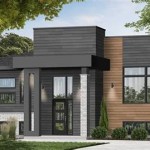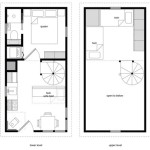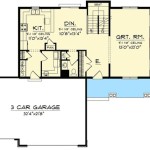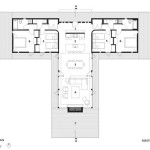House plans for narrow lots are specialized designs that cater to the unique challenges and opportunities presented by narrow building sites. These plans are meticulously crafted to maximize space utilization and create livable and functional homes even in confined areas.
Narrow lots often arise in urban settings or as a result of land subdivision. While they may seem restrictive at first glance, they offer the potential for creative and innovative housing solutions. House plans for narrow lots prioritize vertical space, incorporate natural light, and employ clever storage solutions to ensure that every inch is used efficiently.
In the following sections, we will explore the key considerations and benefits of house plans for narrow lots, providing valuable insights for homeowners and builders seeking to optimize space in urban or challenging building sites.
When designing house plans for narrow lots, several key considerations should be taken into account:
- Maximize vertical space
- Incorporate natural light
- Employ clever storage solutions
- Utilize outdoor spaces
- Consider building upwards
- Explore multi-level designs
- Optimize space planning
- Prioritize functionality
- Seek professional advice
By carefully addressing these considerations, homeowners and builders can create livable and functional homes that make the most of narrow lot dimensions.
Maximize vertical space
Maximizing vertical space is crucial in house plans for narrow lots. By utilizing the height of the building, homeowners can create additional living space without expanding the footprint of the home.
One effective way to maximize vertical space is through the use of lofts and mezzanines. These elevated platforms can be used for a variety of purposes, such as creating extra bedrooms, home offices, or play areas. They can also be used to create a sense of openness and grandeur within the home.
Another way to maximize vertical space is to incorporate vaulted ceilings and skylights. Vaulted ceilings create a more spacious feel and allow for the installation of large windows, which can flood the home with natural light. Skylights are another excellent way to bring natural light into the home while also providing ventilation.
Finally, homeowners can utilize vertical space by installing built-in storage solutions. These can include floor-to-ceiling shelves, cabinets, and drawers. Built-in storage solutions not only save space but also create a more organized and streamlined look.
By maximizing vertical space, homeowners can create livable and functional homes that make the most of narrow lot dimensions.
Incorporate natural light
Incorporating natural light into house plans for narrow lots is essential for creating a bright and inviting living space. Natural light can also help to reduce energy costs and improve overall well-being.
- Maximize window size and placement
One of the most effective ways to incorporate natural light is to maximize the size and placement of windows. Large windows allow more light to enter the home, while carefully placed windows can direct light into specific areas, such as dark corners or hallways.
- Utilize skylights and solar tubes
Skylights and solar tubes are another excellent way to bring natural light into the home, especially in areas where traditional windows are not possible. Skylights are installed in the roof, while solar tubes are installed in the ceiling. Both skylights and solar tubes can provide a significant amount of natural light, even in narrow homes.
- Choose light-colored finishes
Light-colored finishes, such as white or beige, reflect light and help to create a brighter space. Darker colors, on the other hand, absorb light and can make a room feel smaller and darker.
- Use mirrors and other reflective surfaces
Mirrors and other reflective surfaces, such as glossy tiles or polished metal, can help to bounce light around a room and make it feel larger and brighter. Mirrors can be placed opposite windows to reflect light back into the room, while reflective surfaces can be used to create a sense of continuity and flow.
By incorporating natural light into house plans for narrow lots, homeowners can create a more inviting, healthier, and energy-efficient living space.
Employ clever storage solutions
In house plans for narrow lots, every inch of space must be used efficiently. This means that homeowners need to be creative and resourceful when it comes to storage solutions.
One clever storage solution is to utilize vertical space. Floor-to-ceiling shelves and cabinets can be used to store a variety of items, from books and dishes to clothing and toys. Wall-mounted shelves and organizers can also be used to maximize vertical space, and can be used to store items that are not frequently used.
Another clever storage solution is to use hidden storage. This can include things like under-bed storage, built-in drawers, and secret compartments. Hidden storage is a great way to keep clutter out of sight and make a home feel more spacious.
Finally, homeowners can also utilize outdoor space for storage. This can include things like sheds, garages, and decks. Outdoor storage can be used to store items that are not frequently used, such as seasonal decorations or lawn equipment.
By employing clever storage solutions, homeowners can create livable and functional homes that make the most of narrow lot dimensions.
Utilize outdoor spaces
In house plans for narrow lots, it is important to utilize outdoor spaces to maximize the functionality and livability of the home.
One way to utilize outdoor spaces is to create an outdoor living area. This can include a patio, deck, or porch. Outdoor living areas can be used for a variety of purposes, such as entertaining guests, relaxing, or simply enjoying the outdoors. When designing an outdoor living area, it is important to choose furniture that is both comfortable and weather-resistant. Homeowners may also want to consider adding a fire pit or outdoor kitchen to their outdoor living area.
Another way to utilize outdoor spaces is to create a garden. Gardens can be used to grow vegetables, fruits, and flowers. They can also be used to create a beautiful and tranquil space for relaxation. When designing a garden, it is important to choose plants that are appropriate for the climate and soil conditions. Homeowners may also want to consider adding a water feature, such as a fountain or pond, to their garden.
Finally, homeowners can also utilize outdoor spaces for storage. This can include things like sheds, garages, and decks. Outdoor storage can be used to store items that are not frequently used, such as seasonal decorations or lawn equipment. When choosing outdoor storage solutions, it is important to choose items that are both durable and weather-resistant.
By utilizing outdoor spaces, homeowners can create livable and functional homes that make the most of narrow lot dimensions.
Consider building upwards
In house plans for narrow lots, building upwards is a great way to maximize space and create a more livable home.
- Increase square footage
Building upwards allows homeowners to increase the square footage of their home without expanding the footprint of the home. This is especially beneficial in narrow lot homes, where every inch of space is precious.
- Create more rooms
Building upwards can also allow homeowners to create more rooms in their home. For example, a two-story home can have a bedroom and bathroom on the first floor and a second bedroom and bathroom on the second floor. This is a great way to add more living space to a narrow lot home without sacrificing outdoor space.
- Take advantage of views
Building upwards can also allow homeowners to take advantage of views. For example, a home with a second-story balcony can offer stunning views of the surrounding area. This is a great way to enjoy the outdoors from the comfort of your own home.
- Create a more efficient home
Building upwards can also create a more efficient home. For example, a two-story home can have the living room and kitchen on the first floor and the bedrooms on the second floor. This can help to reduce energy costs by keeping the heated and cooled air on the same level.
Overall, building upwards is a great way to maximize space and create a more livable home on a narrow lot.
Explore multi-level designs
Multi-level designs are a great way to maximize space and create a more livable home on a narrow lot. By utilizing the vertical space, homeowners can create more rooms, increase square footage, and take advantage of views.
- Split-level homes
Split-level homes are a type of multi-level home that is characterized by its staggered floor levels. This type of home is often built on sloping lots, as it allows homeowners to take advantage of the natural grade of the land. Split-level homes typically have a living room and kitchen on the main level, with bedrooms and bathrooms on the upper and lower levels. This type of design is a great way to create a more spacious home on a narrow lot, as it allows homeowners to spread out the living space over multiple levels.
- Raised ranch homes
Raised ranch homes are another type of multi-level home that is popular on narrow lots. This type of home is characterized by its elevated first floor, which is typically accessed by a set of stairs. The first floor of a raised ranch home typically contains the living room, kitchen, and dining room, while the lower level contains the bedrooms and bathrooms. This type of design is a great way to create a more private living space, as the bedrooms are located on a separate level from the main living areas.
- Multi-story homes
Multi-story homes are a great way to maximize space on a narrow lot. This type of home has multiple stories, each with its own set of rooms. Multi-story homes are typically more expensive to build than other types of multi-level homes, but they offer the most space and flexibility. This type of design is a great option for families who need more space, or for homeowners who want to create a more vertical living space.
- Townhouses
Townhouses are a type of multi-level home that is typically found in urban areas. This type of home is characterized by its attached design, which shares one or more walls with neighboring units. Townhouses typically have multiple stories, with the living room and kitchen on the main level, and the bedrooms and bathrooms on the upper levels. This type of design is a great way to maximize space in urban areas, as it allows homeowners to live in a multi-level home without having to purchase a large lot.
Multi-level designs are a great way to create more space and functionality on a narrow lot. By utilizing the vertical space, homeowners can create more rooms, increase square footage, and take advantage of views.
Optimize space planning
Optimizing space planning is essential in house plans for narrow lots. This means carefully considering the layout of the home to make the most of the available space. One way to optimize space planning is to use an open floor plan.
An open floor plan is a layout in which the main living areas of the home, such as the living room, dining room, and kitchen, are combined into one large space. This type of layout can make a home feel more spacious and inviting, and it can also make it easier to move around. Open floor plans are a great option for narrow lot homes, as they can help to maximize the sense of space.
Another way to optimize space planning is to use multi-purpose furniture. Multi-purpose furniture is furniture that can be used for multiple purposes. For example, a coffee table with built-in storage can be used to store books, magazines, and other items. Multi-purpose furniture is a great way to save space in a narrow lot home, as it can eliminate the need for additional furniture pieces.
Finally, homeowners can also optimize space planning by using vertical space. This means using the height of the home to create additional storage and living space. For example, homeowners can install built-in shelves and cabinets to store items that would otherwise take up floor space. They can also use lofts and mezzanines to create additional bedrooms or living areas.
By optimizing space planning, homeowners can create livable and functional homes that make the most of narrow lot dimensions.
Prioritize functionality
In house plans for narrow lots, prioritizing functionality is essential to create a livable and comfortable home. This means carefully considering how the space will be used and designing the home accordingly.
One way to prioritize functionality is to create a floor plan that flows well. The floor plan should be designed so that there is a logical flow from one room to the next. This will make it easier to move around the home and will help to create a more efficient use of space.
Another way to prioritize functionality is to choose furniture and fixtures that are both stylish and practical. For example, a sofa bed can provide both seating and sleeping space, while a coffee table with built-in storage can help to keep the living room organized. When choosing furniture and fixtures, it is also important to consider the scale of the space. Oversized furniture can make a narrow lot home feel even smaller, so it is important to choose pieces that are appropriately sized.
Finally, it is important to make sure that the home has adequate storage space. This will help to keep the home organized and clutter-free. Storage space can be incorporated into the design of the home in a variety of ways, such as built-in shelves and cabinets, closets, and drawers.
By prioritizing functionality, homeowners can create livable and comfortable homes on narrow lots.
Seek professional advice
When designing house plans for narrow lots, it is advisable to seek professional advice from an architect or designer. A professional can help to ensure that the home is designed in a way that maximizes space, functionality, and aesthetics.
- Expertise and experience
Architects and designers have the expertise and experience to design homes that are both beautiful and functional. They can help to create a floor plan that flows well and makes the most of the available space. They can also recommend furniture and fixtures that are both stylish and practical.
- Code compliance
Architects and designers are familiar with the building codes that apply to narrow lot homes. They can help to ensure that the home is designed in accordance with these codes, which will help to avoid costly delays and setbacks during the construction process.
- Cost savings
Although it may seem counterintuitive, hiring a professional to design a house plan for a narrow lot can actually save money in the long run. A professional can help to avoid costly mistakes that could result in change orders during construction. They can also help to identify cost-effective ways to build the home, such as using sustainable materials or incorporating energy-efficient features.
- Peace of mind
Hiring a professional to design a house plan for a narrow lot can give homeowners peace of mind. They can rest assured that the home is being designed by a qualified professional who has their best interests in mind.
Overall, seeking professional advice is a wise decision for homeowners who are planning to build a house on a narrow lot. A professional can help to ensure that the home is designed in a way that maximizes space, functionality, and aesthetics, while also complying with building codes and saving money in the long run.










Related Posts








